Last Updated on April 4, 2024

Estimated reading time: 28 minutes
By Jim Ferri and Marjorie Kean
This is not your typical cruise.
But then, the Octantis is not your typical ship.
In fact, Octantis differs radically from all other cruise ships.
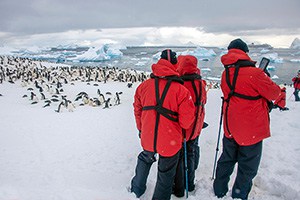
First and foremost, it’s not full of kids, since all guests must be 18 years and older. Also, there is no casino or formal nights. And it’s not a party ship where you can sunbathe by the pool (although there are pools on Octantis). Or order drinks with colorful little umbrellas.
As for its cabins, they are all exterior with an ocean view. And they all have free Wi-Fi and TV.
Then there’s its size. Royal Caribbean’s Wonder of the Seas carries almost 7,000 passengers. Its Harmony of the Seas, 6,687. Viking’s Octantis maxes out at 378, which makes it nice and cozy.
But the final differentiator is that a sail on the Viking Octantis is not just a cruise vacation. Instead, it’s a “thinking person’s adventure,” an expedition in Antarctica aboard a five-star ship built for five-star adventures. During the northern summer, Viking Octantis also cruises on the Great Lakes between the U.S. and Canada.

An Expedition in Antarctica: A Cruise Unlike Any Other
Two weeks ago, we returned from a expedition cruise in Antarctica aboard the Octantis. It was a cruise unlike any we’ve ever experienced, on a ship built for adventure…to the world’s last truly wild frontier.
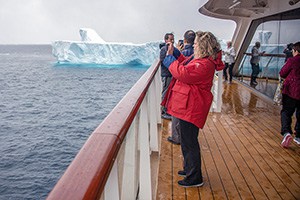
Our adventure began in Buenos Aires, where we joined our fellow cruisers at the Buenos Aires Hilton. The following morning, we all flew to Ushuaia, Argentina, the southernmost town in the world, to board our ship.
If this is your first trip to Argentina, it’s well worth spending a few days pre-trip in Buenos Aires, a beautiful city. It will also help you avoid the pressure of any potential flight cancellations.
Viking handled all the logistics of our excursion exceptionally well. On our trip to the ship and back home, many Viking representatives ushered us on every step along the way. Everything is done with military precision.
The only issue for us was that we would have liked to explore Ushuaia a bit, but we just didn’t have the time.

“Welcome to the Continent of Antarctica”
For many, it’s quite an adventure to visit the 7th Continent. In fact, on our expedition cruise, some people were posing for photos holding a banner celebrating their arrival in Antarctica.
But I guess because we travel so much, I hadn’t considered how momentous it was to be here.
That was until I stepped ashore for the first time, and a guide shook my hand and said, “Welcome to the Continent of Antarctica. You’re now standing on the actual Continent.” Later, Viking gave all of us certificates attesting to the event. It makes you realize you’ve entered a whole new world.
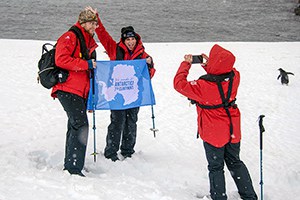
It’s quite a voyage of adventure discovering this new world. And truthfully, it’s pretty exciting. But as one might expect, there are rules you must follow. That’s not just for safety’s sake, but also to prevent tourists and tour companies from ruining the place as they have in many areas of the world.
(As a side note, seven countries – Argentina, Australia, Chile, France, New Zealand, Norway, and the United Kingdom – have made territorial claims in Antarctica, although no government recognizes the claim of any other country.)
Viking is a member of the International Association of Antarctica Tour Operators (IAATO). Thankfully, the association brings some level of protection to the fragile environment by setting landing regulations and bio-security standards for the sensitive environment.
These regulations for expeditions in Antarctica include limiting the size of ships and where and when they can disembark. It also forbids picking up anything or leaving anything behind. But, most importantly, it forbids visitors from approaching or touching any animals or birds.

Setting Off On An Adventure

Although you need special clothes for an Antarctica expedition (see What Clothing You Need to Wear in Antarctica), Viking provides you with an excellent heavy-duty outer jacket. It’s yours to keep, so leave room in your luggage.
Viking also loans you waterproof pants and boots to use on excursions ashore. The boots are a bit cumbersome and clunky and take some getting-use-to. And whenever you return to the ship, the crew hoses down and sterilizes them. Make certain that you put your boots and other clothes you wore on the expedition into your cabin drying closet each day.

No Polar Bears On An Antarctica Expedition
Don’t expect to see polar bears on an expedition cruise, since they only exist in the Arctic in the north, not in Antarctica. What you find in Antarctica, however, are penguins, seals, whales, birds, and more.
Three vehicles are in use when you set off on any Antarctica adventure.
The first is the Zodiacs, heavy-duty, reinforced inflatable rafts that carry 10-12 people. Developed for expeditions, they are incredibly safe and are the only vehicles used for landings.

The second is Octantis’ Special Operation Boats (SOBs), rugged military-grade boats constructed with ice-strengthened aluminum and powered by two 450-horsepower, water-jet propulsion engines. They have 12 individually suspended seats, making for a smooth and fast ride, no matter the sea conditions.
The SOBs are used only to nature-watch along the shore and are powerful enough to get you where you want to go fast when the opportunity arises. While cruising about on an SOB, we saw whales spouting in the distance and were quickly off for a closer look.
The third is 2-seater kayaks. Easy to operate, the kayaks have a pedal system that lets kayakers glide through the water hands-free or use a paddle if preferred.

Experiencing the Wilderness
On its Antarctica expeditions the focus of the ship’s daily itineraries is the nature all around you. Some of the Zodiac excursions brought us to beautiful areas of the snowy wilderness.
Before we even set foot on land on these trips, however, we were humbled by the incredible landscape of beautiful blue icebergs (yes, they are blue), immense glaciers, snow-covered hills, and mountains, all picture-perfect below a stunning blue sky.

We had never seen a sky so blue and clear as we did here, likely due to the lack of pollution. And it all was so quiet. You heard nothing but the sounds of nature…a glacier calving, the squawk of penguins in the distance, and the crunch of snow beneath your boots.
The crew would go out earlier everywhere we went, in order to prepare for our arrival. Even so it was amazing when we arrived on Cuverville Island to see that the team had used shovels to carve steps in the snow up an embankment from our Zodiac landing site.

snow
They had also trampled paths to provide a more solid surface on which we could walk since the snow was still several feet deep. Upright poles had been put in place to show where we could walk. Crossed poles signified off-limits areas. It’s a sound system that ensures your safety and protects wildlife.
“Stay on the paths we’ve made since you can sink into the snow,” we were advised. Nevertheless, on a few occasions, I found myself hip-deep in the stuff before a fellow guest would help me get back on my feet.
On this Antarctica expedition nothing was left to chance. There were helping hands everywhere.

Penguin Heaven on an Antarctica Expedition
Cuverville Island turned out to be penguin heaven. It’s home to more than 13,000 Gentoo penguins, all dressed in little tuxedos. It’s the largest Gentoo colony in the world, and the air is always full with the racket of their continual squabbling.
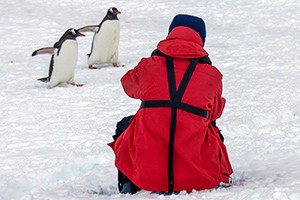
However, they weren’t all together in one group but in several large groups on the shore and mountainside.
In our shipboard briefings on our Antarctica expedition, we were advised that penguins and other wildlife have the right of way while ashore. For example, if a penguin approaches, you stop and let it pass by. Also, we were warned to avoid penguin poop. It’s incredibly stinky, and the smell is nearly impossible to remove from your clothes.
It was good to know since, lacking any fear of man, they seemed as inquisitive of us as we were of them. One or two would often wander over within 10 feet or so of us.

Aside from the penguin and birds on Cuverville, the only mammal we encountered was a seal lying in the snow.
There were two other interesting discoveries on the island, both off-limits to us. One was a red, wood survival hut on the end of the island.
The other was another part of the Gentoo colony. It was a separate neighborhood of sorts, being studied by scientists.

A Ship Built For Exploration and Luxury

The design of Octantis is that of an exploration ship built for luxury adventure. It is named after Sigma Octantis, the southern star (also known as Polaris Australis) that hovers over the South Pole. (Its sister ship Polaris is named for the North Star).
Octantis sails to Antarctica during winter in the Northern Hemisphere (the Southern Hemisphere’s summer) and the Great Lakes of the US and Canada in the northern summer months. To access the Great Lakes beyond Lake Ontario, Viking had to adjust the ship’s specifications to squeeze through the Welland canal near Niagara Falls.

The ship’ primary mission, however, is to take cruisers to the most remote areas of the world, including expeditions in Antarctica. So it has a reinforced bow that lets it operate in harsh polar regions. And also all the hi-tech stuff, such as stabilizers to smooth out the ride, allowing it to operate safely and comfortably even in extreme conditions.
It also has a Dynamic Positioning System, which uses GPS to maintain or change its position. While in Antarctica, we never dropped an anchor, instead using Dynamic Positioning to continually fine-tune the ship’s position and keep it stationary where it was meant to be. It’s the same system in use by oil rigs.
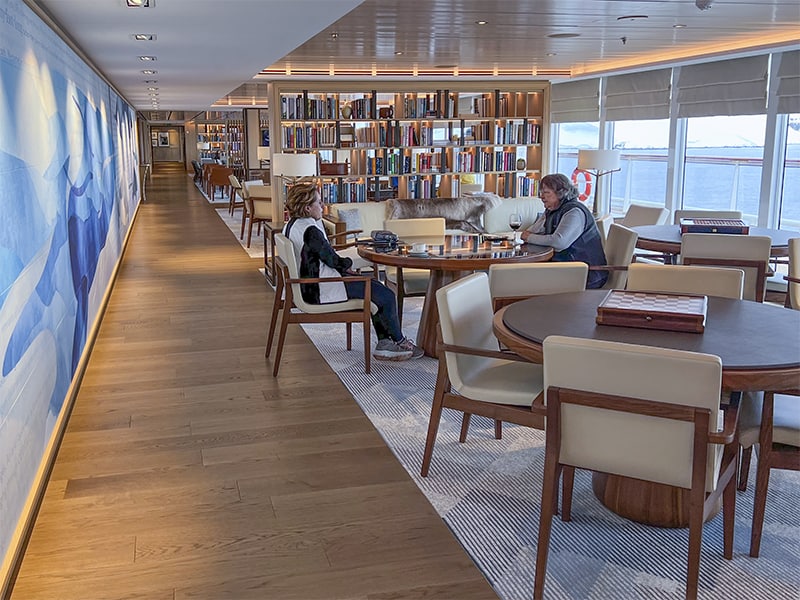
Understated Elegance on An Antarctica Expedition
Octantis’ interior has a Scandinavian design with understated elegance and an extraordinary amount of open space. In fact, you could be in many different areas of the ship and feel that you had the place all to yourself.

Everywhere about the ship, we found little nooks to relax in and other surprising touches. Its elevator doors, for example, have etchings of great global navigational routes. In the hallway leading to the Spa, we found names of world cities set in brass on the floor. Some hallway walls have incredible archival photographs of past Arctic expeditions.
The “Living Room,” a place we visited many times, is a large space with leather chairs, puzzles, and Microsoft high-tech game tables (which you had to yourself). Located high on the ship to maximize views through the floor-to-ceiling windows, there you’ll find live classical music or a soothing piano sonata, something we didn’t expect on an expedition in Antarctica. With Nordic furnishings, relevant and engaging books, and a wall mural of a variety of whales represented to scale, it’s both comfortable and enriching.

Relax in The Living Room

We also enjoyed just relaxing on one of the Living Room’s comfortable couches, enjoying a glass of wine while viewing a visual presentation of the art collections on different Viking ships.
Tucked in it is The Library, a literary traveler’s dream. Its contents have been selected from a broad range of titles from world histories to biographies – all curated explicitly for these journeys by London’s Heywood Hill, for years Queen Elizabeth II’s favorite bookseller.
In addition to the bar in The Library and the popular Explorer Lounge, there’s also The Hide, a secret speakeasy. It’s intentionally a word-of-mouth hideaway not advertised to cruise guests to let people “discover” it for themselves. It’s a cozy bar in the ship’s prow and usually not crowded until after dinner, around 9:30-10pm.
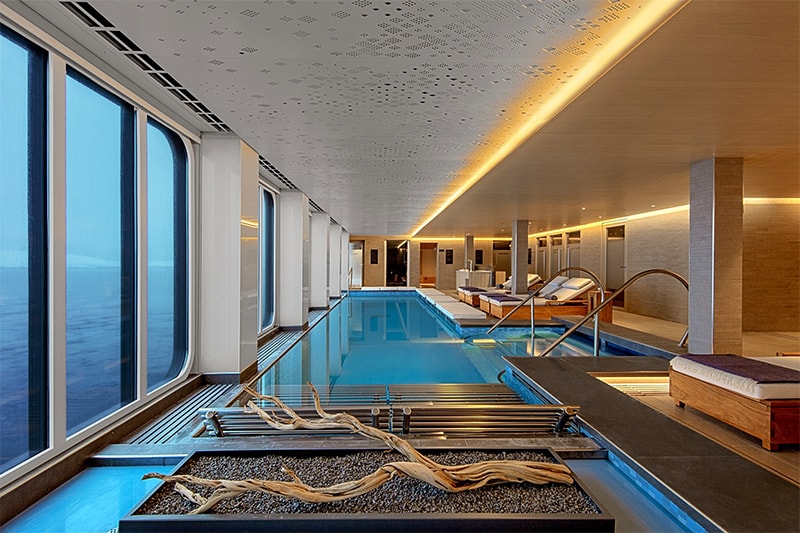
Nordic Spa and Fitness Center
While relaxing in the Nordic Spa, you can view the scenery from the pool through its floor-to-ceiling windows. Following Nordic tradition, Octantis also has a badestamp, a traditional wooden-sided hot tub, and is an excellent place to relax. But be aware of the Scandinavian practice of alternating between hot and cold when relaxing in a spa or sauna. It also offers the typical spa services such as massages, etc.
Octantis’ Fitness Center provides treadmills, stationary bikes, ellipticals, and weight machines. You can also enjoy the sauna, Snow Grotto, and warming cave.
On Deck 5 at the stern of the ship you’ll find the Aquavit Terrace, a bar and pool area that has a retracting roof. But it’s not just one pool here. There are three.
You can access the Tepidarium infinity pool (take notice of the prefix “tepid”), from both inside and outside. The hot-water Caldarium and cold-water Frigidarium are only accessible from outside. You can, however, climb pool ladders between the three.

Spacious Cabins
All cabins on the Viking Octantis are surprisingly spacious and provide extensive storage. In addition, each has a heated drying cabinet for your boots, jackets, and clothes when you return from an expedition.
The cabins have the feel of a five-star hotel, starting with a king-size bed, which the crew can convert into two twins. There’s also a couch (excellent for reading or snoozing), a mini-bar, a Nespresso machine, and more.
The bathroom is also a good size, with fog-free mirrors, an ample-size shower, and a heated floor and heated towel rack.
Each cabin also has a 55″ TV, which, unfortunately, has limited commercial stations. So instead, their primary use is for accessing information you’ll need onboard (including schedules, etc.).
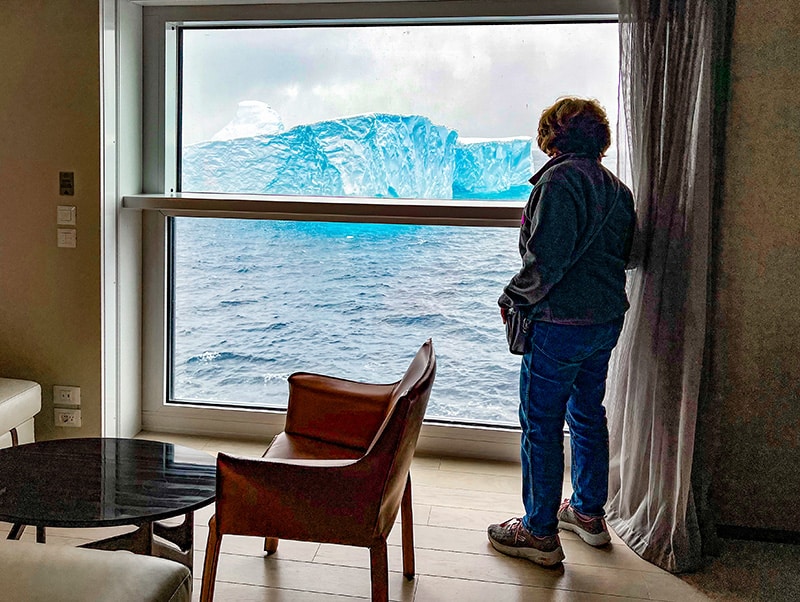
Nordic Balconies, Not Balconies
Except for the highest-level suites, there are no actual balconies in Octantis cabins. Instead, each stateroom has a “Nordic balcony,” a two-part floor-to-ceiling window. The top half lowers into the bottom half at the touch of a button, providing a railing and open-air view (it also has a built-in black-out curtain, also button operated). We found the balconies perfect for this expedition in Antarctica.
The Nordic Balcony is also a great place to view wildlife with the exceptional professional binoculars you’ll find in each cabin, even if you’re still in your pajamas. For example, one day, I saw two whales swim up to the ship right below our cabin before they dove. A few minutes later the Captain made an announcement of two wales frolicking at our stern.
As for the position of the cabins, you’ll want to avoid any at the very front or rear of the ship since these are where you’ll feel the most movement. This is especially relevant on ships sailing to the Antarctic through the Drake Passage.
The Drake Passage is the body of water between South America’s Cape Horn, Chile, and the South Shetland Islands of Antarctica. It’s the place where the Pacific Ocean meets the Atlantic. Since its currents meet no land mass, waves can reach heights higher than 40 feet (12m), making it one of the earth’s most treacherous bodies of water. It’s so legendary among mariners that Viking gives you a certificate certifying that you’ve crossed the passage.

Four Exceptional Restaurants
Octantis dining is like a five-star restaurant experience in a major city, and all meals are included in the cost of your voyage.

There are four restaurants on the ship, two of which, Mandfredi’s and The Restaurant, require reservations (which are free), and there are no additional charges unless you order special wines. Also, jeans are not allowed in these two restaurants.
Mandfredi’s serves delicious pasta and other Italian fares, including Tuscan steaks.
The Restaurant, the other of Octantis’ upscale dining establishments, has a changing menu. It offers some traditional dishes from Norway (a nod towards Viking’s country of origin) and always-available classics. It’s the busiest restaurant at dinnertime.

The World Café
Although there are only four restaurants, you do feel that there are more due to the size of the third restaurant, the World Café. It’s popular and feels more like an upscale food hall at London’s Harrods, with views of the ocean and snow-covered mountains. With live cooking, an open kitchen, premium seafood/sushi choices, and a grill, the casual World Café provides a delicious experience with a wide range of international flavors, including made-to-order pizzas.

At “The Grill” in the Café, you can order burgers, steaks, and seafood, all cooked to order. The Café also has a Sushi Bar (with premium choices), a salad bar, and much more. This is also the place everyone frequents for breakfast (if you haven’t ordered room service). You’ll find just about anything you might like at breakfast…there’s everything for any taste or nationality.
There is no charge for anything at the Café, including wine and beer.
The fourth restaurant is Mamsen’s, for those looking for a snack between meals. Located on Deck 5 near the World Café, it’s named for the owner’s family matriarch. It offers Norwegian specialties, including waffles (from his mother’s original recipe), open-faced sandwiches, and split pea soup.

Submarines on An Antarctica Expedition
In addition to the wildlife viewing, Octantis’ small yellow submarines are possibly the most talked-about elements of the ship. There are two on the ship and another two on Polaris.

Considering their color, Octantis’ submarines have been given the names John and Paul. Those on Polaris, as you may have guessed…are George and Ringo. Each is capable of carrying only six passengers simultaneously, in addition to the pilot. Passengers must squeeze together, three on each side, inside two large bubble-like appendages on the vessel’s sides.
We were given an overview of the submarines at our orientation in the Aula Theater. The theater itself is incredible, with Edvard Munch masterpieces on its window blinds, which retract and provide a 270° view of the landscape surrounding the ship.
Unfortunately, there we were told that the reservation system for booking the subs had gone awry. We were assured that although the technical problems would be fixed, guests would have to be randomly chosen on this trip since there was more demand than available space.
Although there is often a hefty fee for submarine excursions on other cruise lines, on Viking’s expeditions in Antarctica, the submarine excursions are free to guests.

Limitations For Submariners
There are also limitations to taking a trip on the submarines. In the Aula, we were told that anyone with claustrophobia, a medical condition, or an implanted medical device was not allowed. In addition to signing the necessary waivers, one also had to bring their essential medications to survive 94 hours in case of an emergency.
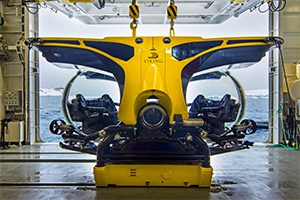
It was at this point that approximately 60% of the audience left. Among those that remained, I later learned I was one of the chosen for one of the several sub rides scheduled during the next few days.
On my submarine excursion the following morning, there were several surprises. The first was that all our bright-red Viking jackets (ours to keep as a memory of our expedition in Antarctica) slowly turned to maroon as we slipped deeper into the ocean, resulting from the blue sea filtering the wavelengths of light. Secondly, there was no pressure change, even though we were diving to 300-400 feet.

Most surprising, however, was that we saw no fish or other marine life except tiny krill. Even at the bottom, vegetation was extremely scarce. Finally, there was some sand and rock; the latter was so flat and rectangular that it looked as if they were stones from an old Roman ruin.
On a previous submarine cruise, just a few weeks earlier, however, there was a very rare sighting of a 30-foot-long phantom jellyfish. In the history of the world, it was only the 115th sighting of such a creature.
However, what we all found interesting was the submarine’s technology. Our young, amiable female pilot was happy to tell us about it and answer our questions.

An Antarctica Expedition Designed for Science
Octantis is a scientific research vessel and is still a working research ship. In fact, it has partnerships with several institutions including the National Oceanic and Atmospheric Administration (NOAA), Scott Polar Research Institute at Cambridge University, and the Cornell Lab of Ornithology, among others. In fact, its onboard expedition team typically includes a biologist, botanist, geologist, glaciologist, and ornithologist.
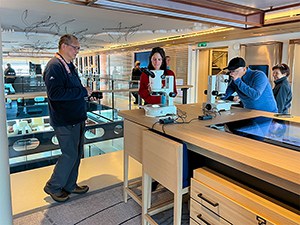
The first place most Antarctica cruisers get their first taste of the ship’s science component is when talking with a team member in Expedition Central on Deck 2, right outside the elevators.
Here guests speak one-on-one with expedition group members about their upcoming activities. Often they’ll use 3D printed maps, digital screens, and a state-of-the-art spatial data visualization chart table to provide a more consumer-oriented view of things.
Octantis also has a fully equipped onboard science laboratory, and its resident and visiting scientists share their research and expertise with you during talks and tours of the lab.

Indeed, take the tour. You’ll learn about active research projects they’re conducting on board and have all your questions answered. It’s quite fascinating.
Across from Expedition Central is The Studio, which includes a display of birds and some penguins you’ll be see on the cruise. Made of felt, each is full-size and and is anatomically exact.
In addition, usually once a week, the scientists release a weather balloon to provide information to NOAA. The Octantis is one of 103 weather-balloon launch stations worldwide and the first to do so as a civilian ship. It’s very popular to watch and attracts many passengers to its 7am launch. Unfortunately, the launch was canceled on our cruise because of inclement weather.

Special Operations Boats
After we spent several days skirting about on Zodiacs, we boarded one of Octantis’ two military-grade Special Operations Boats. Sleek and fast, they hold 12 passengers in individual seats, which you don’t have on the Zodiacs. Making them even more remarkable is that each seat has a shock absorber, which makes for a very comfortable ride, even at high speed.
We spent about an hour cruising along the shoreline, absorbing the beautiful scenery and searching for wildlife. At one point on our expedition, we visited the hulk of an old whaling ship that had caught fire and sank in Antarctica in the early 20th century (luckily, the crew was rescued).

Soon after, our driver spotted whales spouting in the distance and we were off at full speed for a better up-close look.
Unlike the Zodiacs, you board the SOBs from inside the ship in an area called The Hanger. The crew then winches the boats down a ramp into the sea. This means there’s no need to board a boat tossing about in a choppy sea as you do for the Zodiacs. You board the Zodiacs through an access door in the ship’s hull.
You can see the SOBs and all of the Octantis’ equipment, including the scientific paraphernalia, in the Hangar’s “open house” later in the voyage.
Health Considerations
When you book a expedition to Antarctica on Octantis, you must submit a medical questionnaire which must be signed by your physician. Only after approval of the questionnaire by Viking are you accepted for the cruise.
When you board, you’ll find that while using face masks is not required on the cruise, all onboard are required to have a daily Covid test. Octantis has a medical lab that can perform up to 500 Covid tests daily.
The test is non-invasive. Each morning, before brushing one’s teeth, all guests must submit a saliva sample in a test tube left in their cabin the prior evening. You leave the test tube outside your cabin door for collection.
I was told that a few people did test positive on our cruise, and were moved to special cabins in a quarantined area of the ship.
As expected, there is always a doctor and a nurse onboard Octantis. However, there is only one shop onboard, which only sells clothes and gifts. Since it doesn’t sell any medications, even aspirin, you must bring everything you might need. Many people on our trip brought Dramamine in case of sea sickness.

Antarctica Expedition Cost
The cost of an Antarctica expedition cruise aboard the Octantis begins at $15,395 per person. That cost, however, includes things that may incur additional charges on other cruise lines.
Included in the fee are:
- Free airfare and ground transfers
- Hotel in Buenos Aires
- Free Wi-Fi
- All meals
- All crew gratuities (excluding the bar where a 15% gratuity is added to the bill)
- Kayaks, Zodiacs, Special Operations Boats & submarine excursions (where available)
- Keepsake Viking expedition jacket and under-jacket
- Self-service launderettes
- 24-hour room service
- All Viking excursion gear needed
- One complimentary landing or shore excursion in every port of call
- Port taxes & fees
See the entire list at Viking Cruises.

Many thanks for the excellent and very informative report on your trip to Antarctica! We have had a number of great travel experiences with Viking and would love to add this trip to the list. I was especially taken with the amazing colors and contrasts your pictures revealed, and the trip in the submarine must have been a hoot.
Great article! Thanks.
Tom
Thank you Tom. And yes, the submarine was a hoot, as is the entire ship.
Jim
We leave tomorrow for our cruise on the Polaris. Thanks for the information.
Have a great trip Jen. I’m certain you’ll love it.
Jim
Wow, it sounded like an amazing trip. I hope one day I’ll be able to see and enjoy it too.
Hi Suzie,
Yes it was an amazing trip. I hope you’ll be able to see it one day also.
Jim
This looks like a dream trip come true! I